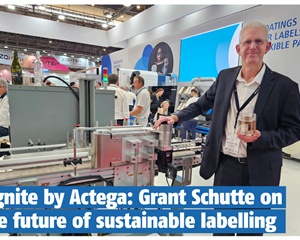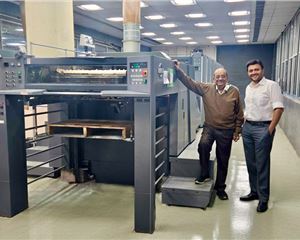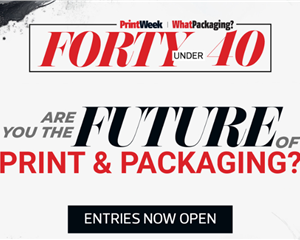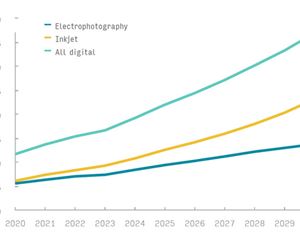Technology Report: Plates, precision and pre-press muscle
Thillai Ganapathy of Esko India and Shaju John of DuPont India explore how automation and plate innovation are reshaping India’s flexo future, one microdot at a time
18 Sep 2025 | By Noel D'Cunha
“High-resolution artwork is non-negotiable,” says Thillai Ganapathy of Esko India. “If the file is low-res, the output will not be great.” A recent test proved the point: a photo-finish label printed at 300 LPI on a standard label press delivered results that rivalled gravure. For converters long used to working at 175 or 200 LPI, the step up is significant.
Getting there requires discipline. Flexo plates, being soft, need retouched images to hold detail. “Your label design has to be prepared for flexo,” Ganapathy explains. He points to three essentials: higher-resolution images, retouched files tailored to the plate, and control marks and impression targets that allow presses to run at kiss impression without drifting.
The impact is visible in applications such as cosmetics and personal care labels, where photographic reproduction of skin tones and fine textures sets brands apart. By adopting these workflows, converters move flexo out of its mid-market comfort zone and into premium categories.
Ganapathy links the quality jump with extended colour gamut (ECG). “If you print with CMYK only, you cover about 79% of the colour space. With ECG using CMYK plus orange, green and violet, you cover far more,” he says. The advantage isn’t only colour reach. A fixed seven-colour palette means converters don’t stop presses to change inks, slashing downtime.
This shift directly addresses the SKU explosion in FMCG and e-commerce packaging. Short runs, multiple variants, and brand colour demands can all be handled with a single set of inks. “Whatever the artwork, you just run it with the standard seven-colour set,” Ganapathy explains.
The message is clear: flexo is no longer chasing gravure quality — it is competing on its own terms, combining photographic reproduction with the agility brands need.
Combination screening technology
“The trend has been 175 or 200 LPI. We are now talking 220 to 350 LPI,” says Ganapathy. The jump is enabled by crystal screening, which mixes amplitude-modulated and frequency-modulated dots. “Your imaging device has to be capable of holding six-micron laser pixels,” he notes. That level of precision was once unthinkable in flexo.
Exposure systems are critical. “Conventional mercury lamps will not cut it. We recommend high-intensity LEDs,” Ganapathy says. Without the right curing, fine highlight dots collapse, robbing imagery of depth. With LED, those dots survive long runs, keeping packages consistent.
He explains how surface engineering adds another layer. “Quartz structures on the plate ensure good ink laydown,” he says. Combined with hybrid dots, they allow converters to reproduce smooth gradients, sharp details and super highlights.
Importantly, Ganapathy insists this is not a laboratory trick. “It is all printed with a generic press set-up,” he says. The technology is designed for practical adoption, not one-off demonstrations. Converters can upgrade step by step, starting with file preparation and screening.
Combination screening integrates seamlessly with extended gamut workflows. By profiling jobs for seven colours, converters avoid ink changes and still hit brand-critical hues. “It is fixed-palette printing. Any job can run on the same ink set,” Ganapathy says.
The payoff is leaner production. Less makeready, less waste, and fewer rejected jobs translate into both savings and confidence. As Ganapathy puts it: “This is about simplifying flexo and still delivering photographic results.”
Fast thermal plate processing
“In thermal processing, it takes about 25 minutes to get a plate out. With solvent, it takes nearly three hours,” says Shaju John, DuPont. “That alone tells you why thermal wins.” Speed is only part of the story. “It is like a Xerox machine. The operator just punches a plate on the processor, and you get the finished plate at the end. No solvents or chemicals, no complicated workflow.”
Sustainability strengthens the case. “DuPont has done a life cycle assessment and reduced non-renewable resource consumption by about 58%,” John says. “Thermal is not only faster, it is greener.” Eliminating solvents also means lower emissions and less hazardous waste, a clear advantage in markets facing stricter compliance.
The investment story is long-term. “We started in 2000 with the first 1000TD thermal processor. In 2016 came the 2000TD. In 2024 we launched the 1000TD. Today, there are more than 1,500 installations worldwide,” John explains. DuPont’s history gives converters confidence that the technology is stable and scalable.
The practical gains are every day. Plates can be produced just minutes before a press run, supporting just-in-time operations and freeing up valuable floor space that would otherwise be occupied by solvent lines. Thermal’s simpler workflow also reduces operator error, improving consistency across shifts.
The combination of speed, simplicity and sustainability makes thermal the new default for converters investing in fresh capacity. “We always suggest going thermal for a sustainable solution,” John concludes.
Next-generation plates
Pre-press doesn’t end with processing. John introduces DuPont’s latest innovation: Lightning plates. “If you use a normal plate, LED exposure takes 25 to 30 minutes. With Lightning, it takes 12 to 15 minutes,” he says. By halving exposure cycles, Lightning aligns pre-press with the speed of thermal processing.
These plates are explicitly engineered for high-intensity LED systems. “They are tailor-made for LEDs. They ensure small six-micron dots are held consistently,” John explains. The precision is critical for converters pushing hybrid screening and ECG workflows into production.
Lightning plates also feature flat-top technology, enhancing ink laydown and colour consistency across various substrates. Converters running multiple short jobs per day report fewer remakes and less downtime. “The benefit is faster exposure with the same or better consistency,” John says.
The portfolio remains broad. DuPont still supports solvent-based plates, such as EPR02, ESXR and ESM, as well as thermal EFXR and DFUV plates. But Lightning is designed for converters moving into LED workflows. By cutting exposure time, it keeps the pre-press chain as agile as the pressroom.
Ganapathy sees this as critical for converters expanding into transparent substrates. “Converters here print not only labels but also transparent materials. They need plates and screening that work together for premium applications,” he says.
In effect, Lightning plates reduce pre-press bottlenecks, support advanced screening, and ensure converters can consistently hit the quality benchmarks brands now expect from flexo.
Easy Brite opacity solutions
Opacity remains a pain point in flexo, especially on clear films. John outlines DuPont’s solution. “We have a new screening technology called Easy Brite. It ensures higher opacity, less mottling and less graininess,” he says.
The savings are tangible. “People using 160 lcm aniloxes can go to 220 or even 280 lcm and still get the same ink laydown,” he adds. That means reduced ink consumption, lower costs and faster drying times. In practical terms, jobs that once needed two hits of white can now be done in one pass.
For applications such as shrink sleeves and clear-on-clear labels, Easy Brite is a game-changer. Stronger, cleaner whites lift shelf impact while cutting energy use and downtime. “You achieve the same coverage with less ink and fewer hits,” John says.
Ganapathy links opacity directly with brand design. “If converters want to deliver photo-realistic images on transparent material, they cannot compromise on opacity. Easy Brite provides a predictable base to build on,” he explains.
By improving both quality and efficiency, Easy Brite shows how incremental advances in screening can solve enduring production challenges. Converters benefit from stronger visual impact, while brand owners gain assurance of consistency.
Industry training empowerment
For both speakers, technology adoption is incomplete without skills. John explains DuPont’s initiative: “We have introduced Cyrel U, an online training programme with four courses – foundation, beginner, intermediate and advanced. It helps platemakers understand the full concept of platemaking and reduce plate room errors.”
The platform addresses a gap. Many operators rely on informal training, which leads to variability across shifts and plants. Structured modules build competence step by step, from basics to advanced concepts.
Ganapathy stresses the same point. “Converters often underestimate pre-press education. Without it, the benefits of high-resolution imaging and advanced screening cannot be realised on press,” he says. Training, he argues, is the bridge between technological potential and production reality.
The collaboration between suppliers is deliberate. Esko and DuPont have both invested in award-winning technologies, but the real value is unlocked only when converters understand how to use them fully.
John positions training as part of sustainability. “It is not just about selling plates or processors. It is about sharing with the industry the knowledge to achieve consistent quality,” he says. Reducing rework, cutting waste, and standardising workflows all depend on human capability.
Cyrel U, combined with supplier-led workshops, enable converters don’t just buy new tools, they build the skills to exploit them. That, Ganapathy and John agree, is what will keep flexo competitive long after the current wave of technology launches.












 See All
See All